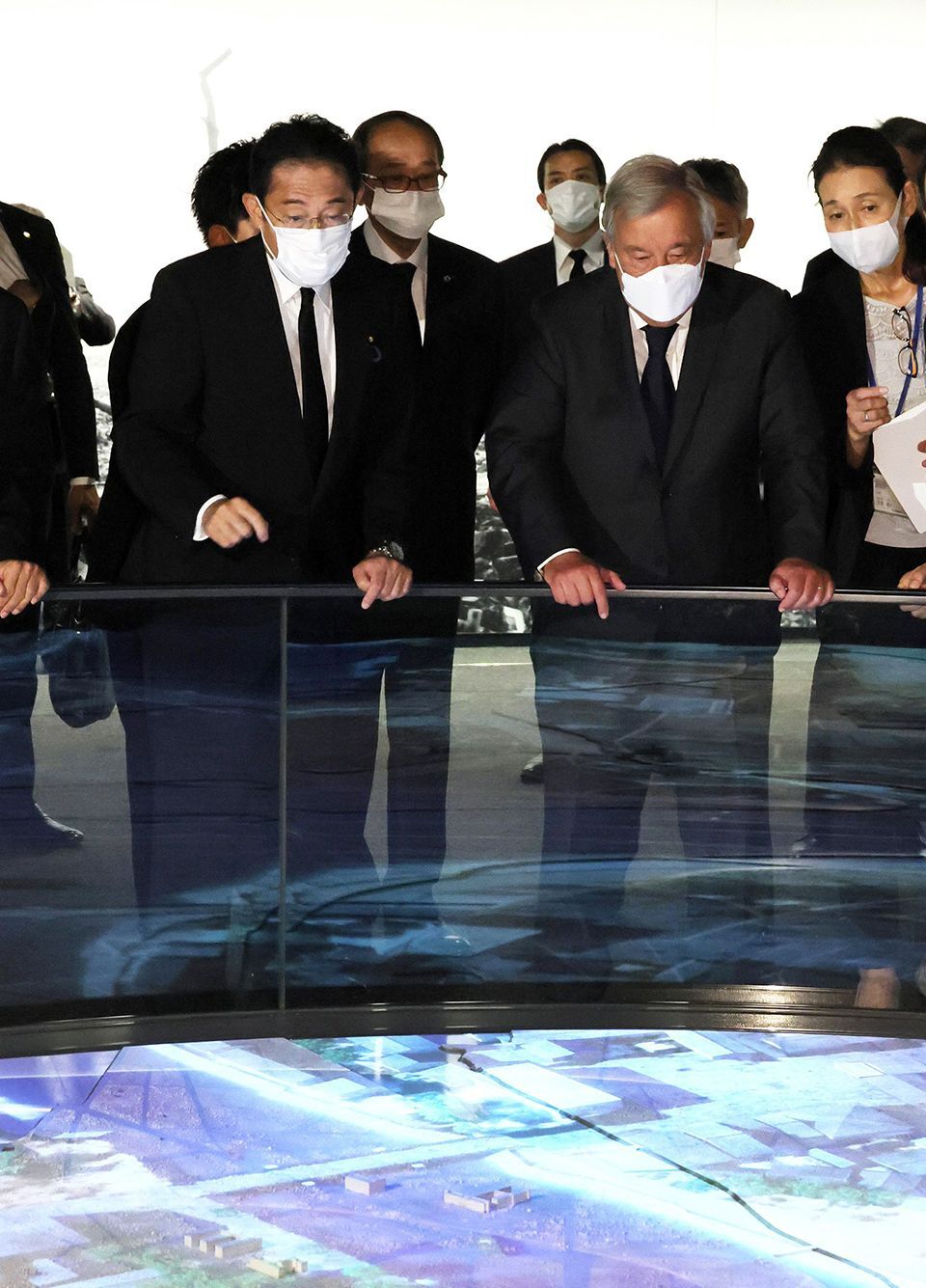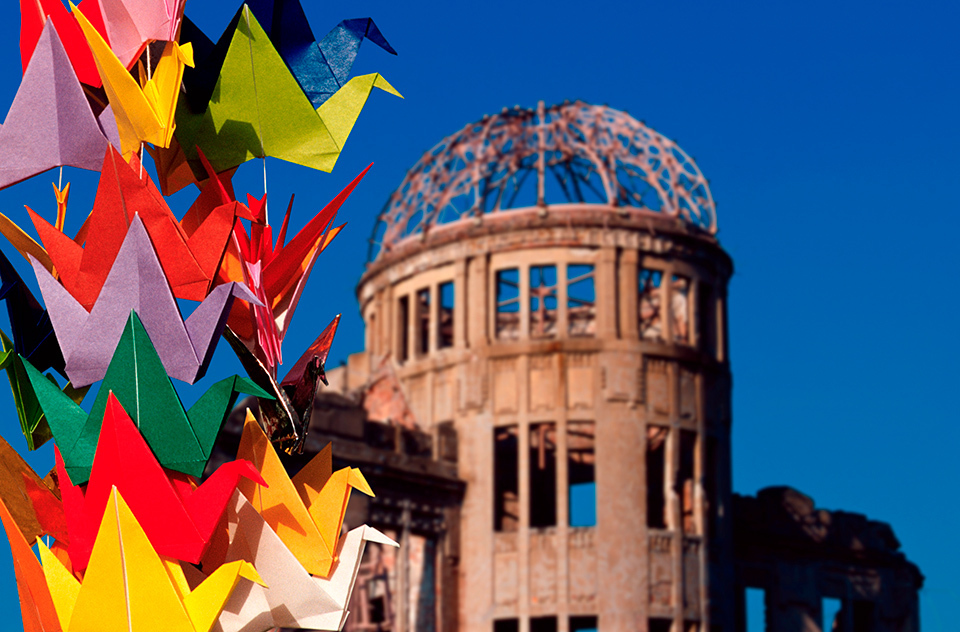Prime Minister Kishida delivering his speech at the Tenth Review Conference of the Parties to the Treaty on the Non-Proliferation of Nuclear Weapons (NPT). He outlined the five pillars of the “Hiroshima Action Plan,” the first step towards realizing a world without nuclear weapons.
On August 1, 2022, Prime Minister Kishida attended the Review Conference of the Parties to the Treaty on the Non-Proliferation of Nuclear Weapons (NPT) in New York, as the first Japanese premier to attend an NPT Review Conference. In a speech delivered at the general debate, he expressed Japan’s strong determination to work together with other state parties to firmly uphold the NPT as one of its guardians.
1. Introduction
Your Excellency Mr. President, Excellencies, Distinguished Delegates,
Today, I have come to this Review Conference driven by a strong sense of urgency.
As Foreign Minister, I attended the 2015 Review Conference which ended without reaching consensus. Since then, the division within the international community has become only greater. In particular, the threat to use nuclear weapons by Russia in its aggression against Ukraine, has contributed to worldwide concern that yet another catastrophe by nuclear weapon use is a real possibility.
I cannot but admit that the path to a world without nuclear weapons has become even harder.
2. Thoughts towards the NPT Review Conference
Nevertheless, giving up is not an option.
As a Prime Minister from Hiroshima, I believe that we must take every realistic measure towards a world without nuclear weapons step by step, however difficult the path may be.
The very starting point of this endeavor is the NPT. The NPT has served as the cornerstone of the international nuclear disarmament and non-proliferation regime in realizing international peace and security.
Maintaining and strengthening the NPT regime is in the interest of the entire international community. Let us join forces to achieve a meaningful outcome at this Conference. Together with all of delegates concerned here today, Japan is determined to firmly uphold the NPT as its guardian.
3. Road map that will take us from the “reality” to the “ideal”
Mr. President,
As the first step of a realistic road map, which would take us from the “reality” we face in the harsh security environment to the ideal of a world without nuclear weapons, we will work on the “Hiroshima Action Plan” which is rooted in the following five actions, while simultaneously making efforts to reduce nuclear risks.
As the first action, I call for a shared recognition on the importance of continuing the record of non-use of nuclear weapons. We should never tolerate the threat of the use of nuclear weapons, such as that made recently by Russia, let alone the use of nuclear weapons. We must ensure that Nagasaki remains the last place to suffer an atomic bombing.
The second action is to enhance transparency. Transparency is the foundation of all nuclear disarmament measures. I call on nuclear-weapon States to enhance the transparency of their nuclear forces. In particular, I call on all nuclear-weapon States to disclose information on the status of production of fissile materials. This is an important step to gather momentum for the commencement of negotiations on an FMCT.
The third action is to maintain the decreasing trend of the global nuclear stockpile. While the number has significantly decreased since the peak of the Cold War, there are still more than ten thousand nuclear weapons in the world. Maintaining this decreasing trend is extremely important in getting closer to a world without nuclear weapons.
To achieve this, I call on all nuclear-weapon States to engage in a responsible manner. In this vein, Japan supports the dialogue conducted between the United States and Russia for further reduction and encourages the US and China to engage in a bilateral dialogue on nuclear arms control and disarmament.
We should breathe new life into the discussions on the CTBT and an FMCT. In order to build momentum towards facilitating the entry into force of the CTBT, I will convene a meeting of the CTBT Friends at the leader’s level during the United Nations General Assembly in September. I reiterate our call for the immediate commencement of negotiations on an FMCT.
The fourth action is to secure nuclear non-proliferation and promote the peaceful uses of nuclear energy upon that basis. While there are concerns about the possibility of another nuclear test, Japan will address North Korea’s nuclear and missile issues in coordination with the international community.
The return to compliance with the Iran nuclear agreement is also yet to be realized. Japan will contribute proactively towards facilitating dialogue. The peaceful uses of nuclear energy should go hand in hand with nuclear safety. The recent attacks on nuclear facilities by Russia must not be tolerated. Building on the lessons learned from the 2011 accident, Japan will continue to reconstruct the affected areas and address various challenges associated with decommissioning of the nuclear power station. In close cooperation with the international community, including the IAEA, Japan will continue to advance its efforts in a transparent manner in accordance with domestic and international safety standards.
For the fifth action, Japan will promote the accurate understanding on the realities of nuclear weapons use through encouraging visits to Hiroshima and Nagasaki by international leaders and others.
In this connection, I welcome the visit by Secretary General Antonio Guterres to Hiroshima on August 6.
Japan shall make a contribution of ten million dollars to the United Nations in order to set up a “Youth Leader Fund for a world without nuclear weapons.” By inviting future leaders to Japan and providing them with opportunities to learn firsthand the realities of nuclear weapon use, this will create a global network among the youth towards the elimination of nuclear weapons.
4. Conclusion
In order to build global momentum towards a world without nuclear weapons, I decided to hold the first meeting of the new “International Group of Eminent Persons” on November 23 in Hiroshima, which will enjoy the involvement of former and incumbent political leaders of the world.
Mr. President,
In 2023, Japan will host the G7 Summit in Hiroshima. It is my intention to demonstrate our firm commitment from Hiroshima to never repeat the catastrophe of atomic bombings.
Today, I have folded a paper crane and brought it with me here. SASAKI Sadako, the girl whose image served as the model for the Children’s Peace Monument in the Hiroshima Peace Park, kept folding paper cranes, wishing to live. Today, paper cranes have come to symbolize worldwide prayers for peace and a world without nuclear weapons.
I will make steps towards a world without nuclear weapons together with all the people who share the common aspiration around the world.
Thank you.

Prime Minister Kishida and António Guterres, Secretary-General of the United Nations (UN), visited the Hiroshima Peace Memorial Museum on August 6, 2022, the 77th anniversary of the world’s first atomic bombing. On that day, the Peace Memorial Ceremony for the victims of the bombing was held, attended by representatives from 99 nations, as well as those from the European Union and international organizations including the UN.

The Atomic Bomb Dome received the full force of the blast as it lay just around 160 meters from the bomb’s epicenter. Despite most of the building’s interior having burnt down, its outer structure has been preserved almost intact, appearing as it was immediately after the bomb exploded. The Hiroshima Peace Memorial Park, where this World Cultural Heritage site is located, is adorned throughout with paper cranes, which are considered symbols of peace. AFLO
Left: Prime Minister Kishida and António Guterres, Secretary-General of the United Nations (UN), visited the Hiroshima Peace Memorial Museum on August 6, 2022, the 77th anniversary of the world’s first atomic bombing. On that day, the Peace Memorial Ceremony for the victims of the bombing was held, attended by representatives from 99 nations, as well as those from the European Union and international organizations including the UN.
Right: The Atomic Bomb Dome received the full force of the blast as it lay just around 160 meters from the bomb’s epicenter. Despite most of the building’s interior having burnt down, its outer structure has been preserved almost intact, appearing as it was immediately after the bomb exploded. The Hiroshima Peace Memorial Park, where this World Cultural Heritage site is located, is adorned throughout with paper cranes, which are considered symbols of peace. AFLO







































